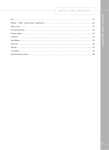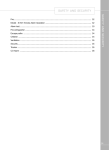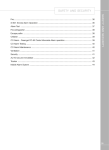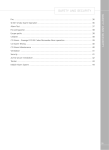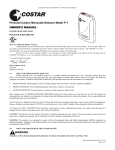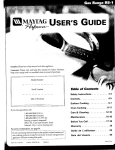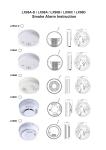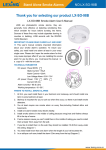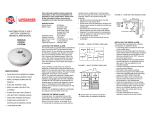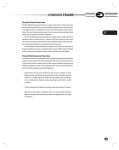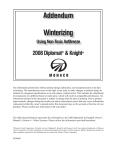Download Safety And security
Transcript
safety and security Model - SI 601 Smoke Alarm Operation..................................................................................... 32 Alarm test.................................................................................................................................. 33 Escape paths . ........................................................................................................................... 34 Children ................................................................................................................................... 34 Ventilation ................................................................................................................................ 35 CO Alarm ................................................................................................................................. 36 Hartal Exterior Doors . ............................................................................................................... 38 sa f e t y a nd s e curit y Fire............................................................................................................................................ 32 31 s a fe t y a nd s e curity fire and fire alarm Fire BATTERY REPLACEMENT Important: Your attention is drawn to the notice affixed inside the wardrobe advising on fire precaution, ventilation and what to do in case of fire. IMPORTANT: Only the following batteries can be used for replacement. Use of a battery other than those recommended below may have a detrimental effect on the detector’s operation. Use of a lithium (long-life) battery could provide power for 10 years under normal operating conditions, meaning there is no need for an annual battery change. IN CASE OF FIRE 1.Get everyone out of the motorhome as quickly as possible using whichever exit is the quickest, including windows. Do not stop to collect any personal items. 2.Raise the Alarm. Call the Fire Brigade. 3.Turn off the gas supply valve if it is safe to do so. NOTE: Upon delivery the battery may be fitted with a protective cover. Please ensure this is removed before use. 4.Turn off the electricity supply at supply point. Carbon-Zinc type: MODEL- SI 601 SMOKE ALARM OPERATION Eveready Energizer 1222; Gold Peak 16045 (UL). Normal condition Alkaline Type: The red LED on the front should flash once every 40 seconds to show the alarm is active. Energizer 522; Duracell MN 1604; Duracell 9V Low Battery Condition IMPORTANT: Your smoke alarm requires a battery with a sufficient capacity of power to operate correctly. This must also be correctly installed. Should your smoke alarm enter a low battery condition, the unit will emit an audible ‘chirp’ once every 40 seconds. When this occurs you must replace the battery immediately. Your smoke alarm will continue to warn of this low battery condition for at least 7 days, however, failure to change the battery after this time would mean your smoke alarm has insufficient power to alert you in a real fire situation. 32 NOTE: The alarm cover can't be installed without a battery fitted. Ultra; Energizer 9V Ultra+; Gold Peak 1604A. Lithium (long life) type: Ultralife U9VL 1.Remove the alarm from its mounting plate by turning anti-clockwise Fire alarm 3.Replace the alarm on its mounting plate, lining up the large central vent on the front of the alarm, with the ‘X’ that is moulded into the plastic on the mounting plate (if unsure see page 13 of the alarm user manual). Ensure the unit is securely fitted. ALARM TEST 1.Press the test button in the centre and release. sa f e t y a nd s e curit y 2.Remove the existing battery and replace with a new battery. From the list on this page, making sure that the positive and negative connections are in the correct position. If unsure see the alarm user manual. 2.The unit will emit a loud (85dB at 3 meters) alarm for around 5 seconds and stop automatically. 3.The red LED on your alarm will flash rapidly during the audible signal. 4.Test your alarm as explained in the next section ‘Alarm Test’. 33 s a fe t y a nd s e curity fire alarm NOTE: The test button accurately tests the alarm’s smoke sensing circuit, there is no need to test your alarm with smoke. If your smoke alarm fails to give an audible test signal, please refer immediately to the troubleshooting guide at the end of the user manual. WARNING: Test your smoke alarm at least once per week Your smoke alarm has been designed to be as maintenance - free as possible and although the unit requires only battery maintenance for its entire life, there are several things you must do to keep it working properly. CAUTION: Your smoke alarm is a sealed electrical device and no attempt should be made to open the case. Attempting to open the case will invalidate your Warranty. CLEANING: As a minimum your smoke alarm should be cleaned once every 3 months using your vacuum cleaner fitted with the soft brush attachment. Warning: The electronic test button provides a full test of the unit’s functionality. DO NOT try to test the alarm with a naked flame, as this may present a potential fire hazard. WARNING: Never use portable cooking or heating equipment other than electric heaters that are not of the direct radiant type, as it is a fire and asphyxiation hazard. WARNING: Appliances such as cookers must not be used for heating. Fire Extinguisher It is recommended that a dry powder fire extinguisher be carried inside your motorhome at all times. When using a dry powder extinguisher it is suggested that the motorhome be evacuated until the powder has settled, to avoid inhalation. A fat pan fire should not have a fire extinguisher aimed at it. It should be smothered with a fire blanket. WARNING: Provide one dry powder fire extinguisher of an approved type or complying with ISO 7165, of at least 1kg capacity, by the main exterior door and a fire blanket next to the cooker. WARNING: Your smoke alarm may false alarm when it is being cleaned using a vacuum cleaner. IMPORTANT: Do not use solvents or cleaners on your smoke alarm, as they may cause damage to the sensor or circuitry. The unit can be wiped with a slightly damp cloth. Familiarise yourself with the instructions on your fire extinguisher and the local fire precaution arrangements. Escape paths It is important that you do not block escape paths to emergency exits with obstructions or hazards. Children Do not leave children alone in the motorhome in any event. Keep potentially dangerous items out of reach, as at home e.g. matches, drugs etc. 34 ventilation and security VIN (Vehicle identification Number) All motorhomes comply with BS EN 721. The ventilation points on your motorhome are fixed points of ventilation which are required by the European Standards. Record your motorhome VIN which can be found on the lower edge of the base vehicle front windscreen and the plate located on the front cross member under the bonnet. All motorhomes have ventilation at high level and low level which have been calculated to suit the individual needs of your motorhome. Make a note of these numbers in the space provided at the front of this handbook and make a separate note of the numbers to keep safe at home. High level ventilation is achieved by means of the roof lights and washroom roof ventilators (where applicable). The low level ventilators are positioned in the entrance door stepwell. Under no circumstances must these vents be blocked or obstructed. It is advised that fixed ventilation points are checked and cleaned (if necessary) on a regular basis using a small brush and a domestic vacuum cleaner. Additional night time ventilation is obtained by releasing the window catches and placing them in the second groove. Note the windows are not sealed from rain in this position. Additional security Consider fitting any device which might deter intrusion by thieves. Customers are advised to identify their motorhome with a method for subsequent identification if other forms of identification have been altered or removed. sa f e t y a nd s e curit y Ventilation Free crime prevention advice about securing your motorhome, protecting your valuables, property marking either at home or whilst on site, can be obtained from the Crime Prevention Officer through your local Police station. As the ventilation levels are calculated to suit each models requirements there should be no modifications made which may result in reduced ventilation levels. WARNING: Do not obstruct ventilation. SECURITY - Motorhome theft: The theft of a motorhome can occur in the most unlikely circumstances; from a motorway service area or even an owner's driveway. Secure all windows and doors when your motorhome is unoccupied even if only for a short length of time. 35 s a fe t y a nd s e curity CO alarm CO ALARM Fireangel CO-9X Carbon Monoxide Alarm WARNING: Please read the full user instructions provided. CARBON MONOXIDE Known as the silent killer, Carbon Monoxide is an invisible, odourless and tasteless gas. What are the symptoms of carbon monoxide poisoning? Early symptoms of carbon monoxide (CO) poisoning can mimic many common ailments andmay easily be confused with flu or simple tiredness. Symptoms to look out for include: • Get medical help immediately for anyone suffering the effects of carbon monoxide poisoning (headache, nausea), and advise that carbon monoxide poisoning is suspected. • Do not use the appliance again until it has been checked by an expert. In the case of gas appliances the engineer must be Gas Safe registered. Activating the Alarm • tiredness See diagram below • drowsiness Your detector comes complete with an integrated power pack that will provide power for its entire operational life. To activate the power pack you need to pull the disabling tab (see image). This will in turn pull out the metal disabling clip, which is attached to the end of the tab, from the disabling socket which is situated on the underside of the detector. Retain the disabling tab for future use by taping it to page 20 of the CO-9X user manual. • headaches • giddiness • nausea • vomiting • pains in the chest • breathlessness • stomach pains • erratic behaviour • visual problems Anyone with these symptoms should immediately turn off all appliances and seek medical attention. WHAT TO DO DURING AN ALARM • Keep calm and open the doors and windows to ventilate the property. • Stop using all fuel burning appliances and ensure, if possible, that they are turned off. • Evacuate the property leaving the doors and windows open. • Ring your gas or other fuel supplier on their emergency number; keep the number in a prominent place. 36 • Do not re-enter the property until the alarm has stopped. When exposed to fresh air it can take up to 10 minutes for the sensor to clear and the alarm to stop depending on the level of carbon monoxide detected. When the detector is activated the Power LED will begin to flash green once every minute to indicate that the detector is receiving power from the power pack and is fully operational. Testing the Alarm Test the sounder, power pack and circuitry by pressing and holding the centre of the Test/Reset button briefly to confirm that the detector is operating properly. The sounder will sound as soon as the button is pressed, and the Alarm LED will illuminate red indicating that the sounder is working and the power pack is providing power to the unit. This test for the sounder, power pack and circuitry should be performed on a weekly basis. This should be continued for the lifetime of the product. WARNING: Prolonged exposure to the sounder in close proximity to your ears may damage your hearing. Under normal operating conditions, the power pack will last for the lifetime of the product i.e 7 years. The detector will not protect against the risk of carbon monoxide poisoning when the power pack has drained • Within 3 minutes when exposed to a minimum of 300ppm of CO. Fault / low power pack signal: The unit continuously checks the settings of its sensor and circuitry. If any of these settings are found to be incorrect or if the power pack becomes low then the detector will emit a single chirp once per minute and the Fault LED will flash yellow once per minute for up to 30 days. IMPORTANT: This does NOT mean that the detector has detected carbon monoxide. Maintenance Your detector will alert you to potentially hazardous CO concentrations in your home when maintained properly. To maintain your FireAngel detector in proper working order, and to ensure that the sensor will last for the lifetime of the product, it is recommended that you: • Test the sounder, power pack and circuitry of your detector at least once per week by pressing the Test/Reset button briefly (see above). Sensor Testing. • Perform the Sensor Test once every month (See of the CO-9X user manual for more details). The alarm manufacturer recommends that this is carried out monthly. See of the CO-9X user manual for more details. • Keep the detector free of dust by gently vacuuming the case with a soft brush attachment once per month. CO Alarm operation when CO detected The higher the concentration of carbon monoxide detected by the detector, the quicker it will respond. When sufficient carbon monoxide is detected a loud audible signal (85 dB at 1m (3 feet)) will be emitted and the Alarm LED will flash red once every second. sa f e t y a nd s e curit y Normal Operation of the Alarm To prevent the possibility of contaminating the sensor in your detector and thus affecting its reliability: • Never use cleaning solutions on your detector. Simply wipe with a slightly damp cloth. • Do not paint the detector. The Alarm will sound: • Do not spray aerosols on or near the detector. • Between 60 and 90 minutes when exposed to a minimum of 50ppm of CO. • Do not use any solvent based products near the detector. • Between 10 and 40 minutes when exposed to a minimum of 100ppm of CO. 37 s a fe t y a nd s e curity safety and security 38 Hartal exterior doors Where the Hartalite door is fitted to the Sundance/E400 models and remote central locking has been activated, pull the door handle twice to open the exterior door.








